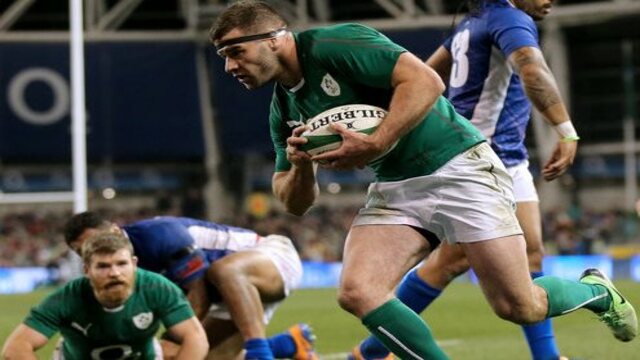For many coaches first phase refers to possession won at scrum or lineout (for example), but for the purpose of this article we are using first phase ball as an umbrella term for the first phase of play from any type of possession – setpiece, turnover and counterattack from a kick (as in this example) New Zealand did it against France and Ireland did it against Samoa. There were several other examples of it across the weekend of international rugby, as there are in nearly every block of games in professional rugby. First phase tries are a thing of beauty, and also an effective way of scoring.
Tries on first phase can arrive in a number of ways. Perhaps the most satisfying for players and coaches is the elusive set piece score, directly from a dominant scrum or lineout and involving both backs and forwards combining to carry out a rehearsed move. Seeing the preparation that has been done on the training ground working to perfection is thrilling for those involved.
Increasingly organized defences have meant that first phase tries from set piece are difficult to create, but there are also advantages for the attacking team. The opportunity to create one-on-ones (not as regular an occurrence as one might think) mean that if the team in possession can perfectly execute their pre-rehearsed moves then they have a decent chance of scoring.
Every aspect of the play needs to go smoothly. The lineout or scrum must provide clean ball, the halfbacks have to put their runners into space with perfect timing and support players are required to be alert. Ireland managed to score on first phase from an attacking scrum against Samoa on Saturday with Fergus McFadden touching down, a score that Joe Schmidt admitted had greatly pleased him (see try on 6mins below.)
New Zealand scored a first phase try in totally different circumstances on Saturday. A poor kick from French fullback Brice Dulin immediately saw the All Blacks switch into counter-attacking mode. Israel Dagg fielded the ball and swiftly sent it in the direction of the other touchline, through the swift hands of Dan Carter and Charles Piutau.
Ben Smith and Kieran Read had worked across to provide width on the other side and when the centre grubber kicked through, he found oceans of space, allowing Piutau to dink it on and touch down. The whole phase of play lasted only 14 seconds and while there was an element of luck after Piutau’s nudge on, the danger posed on first phase counter attack was clearly highlighted.
A poor kick can leave the team who has kicked in a vulnerable, disorganized position. More accurately, it is the transfer of possession that often leaves the team who has lost the ball in a bad defensive position. Shifting from an attacking mindset immediately into defensive mode is not an easy thing to do. That is why coaches need to encourage their players to attack ruthlessly and with pace when there is a transfer of possession.
The key is mindset. The best counter-attacking and turnover tries come when the scoring team is determinedly focused on running the ball back as soon as they get their hands on it. Stealing the ball at the breakdown inside one’s own half is often followed by a kick. There are certainly times when that is the best option but on so many other occasions, a little daring would go a long way.
Attitude is not the only element, as a basic structure can help these apparently unstructured situations become superb attacking opportunities. Many coaches operate under the ‘two pass’ rule, whereby the ball must be shifted to the other side of the pitch in at least two passes. That means shifting play away from where the transfer of possession has happened to an area of the field where fewer defenders are positioned.
The All Blacks’ try through Piutau also showed the benefits of having a defined counter-attacking system. The manner in which Read and Smith moved to the far touchline as soon as Dulin had kicked the ball away was the clear sign that they the All Blacks have worked hard on putting structure on what could be a disjointed situation. In turn, that element of shape allows the All Blacks’ individual attacking skills to come to the fore.
Generally speaking, the majority of tries in rugby at professional level are scored within the first five phases of possession. There still exists the thought that hanging onto the ball for drawn-out, 10 phase passages of play is a good thing, but in terms of scoring that is not an efficient approach. Certainly there are other benefits to maintaining possession, but in terms of tries it is better to strike early and with speed.
Dropped passes, loose kicks, steals at the breakdown and turned over scrums; these are all excellent attacking chances for the team who gains possession. Those moments of switching from attack to defence for the team who has coughed up the ball are difficult to manage. A team with the mindset of striking instantly, and an element of structure to allow them to do so, can be a team who scores first phase tries.
How do you train your team to react quickly to the transfer of possession? How do you build the mindset of immediate attack when a turnover is made? As always, your comments and tips are crucial, so leave a message below…












.jpg)

.jpg)







